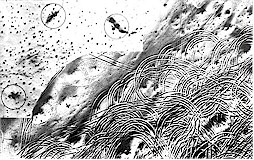
The Battle of Longewala was one of the first major engagements in the western sector during the Indo-Pakistani War of 1971, fought between assaulting Pakistani forces and Indian defenders at the Indian border post of Longewala, in the Thar Desert of Rajasthan. The battle was fought between 120 Indian soldiers accompanied by four Hawker Hunter and three HAL Marut fighter-bombers and 2,000–3,000 Pakistani soldiers accompanied by 30–40 tanks.
Hamidur Rahman was a sepoy in Bangladesh Army during the Bangladesh Liberation War. Rahman was killed on 28 October 1971 at Dholoi during the Battle of Dhalai, Srimangal during an attempt to capture the Pakistani Army position. The advancing Mukti Bahini column finally captured the Dhalai Border Outpost on 3 November 1971. He was posthumously awarded the Bir Sreshtho, the highest recognition of bravery in Bangladesh. The Dhalai post was eventually captured permanently by three infantry battalions belonging to 61 Mountain Brigade, one battalion belonging to East Bengal Regiment and 7 Rajputana Rifles supported by an artillery brigade of the Indian Army fought against 12 Frontier Force Regiment of the Pakistan Army.
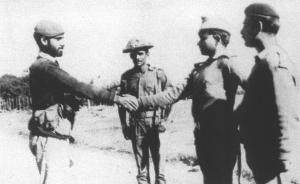
The First and SecondBattles of Hilli were two major battles fought during the Bangladesh Liberation War on 22–24 November and 10–11 December 1971. They are generally regarded as the bloodiest battles of the eastern front of the Indo-Pakistani War of 1971. The first battle saw, according to veterans of the battle, the fiercest fighting of the war, but the second was much tamer.
Muhammad Ataul Gani Osmani, was a Bengali military leader. Osmani's career spanned five decades, beginning with service in the British Indian Army in 1939. He fought in the Burma Campaign during World War II. After the partition of India in 1947, he joined the Pakistan Army and served in the East Bengal Regiment, retiring as a colonel in 1967. Osmani joined the Provisional Government of Bangladesh in 1971 as the commander-in-chief of the nascent Bangladesh Forces. Regarded as the founder of the Bangladesh Armed Forces, Osmani retired as a four-star general from the Bangladesh Army in 1972.
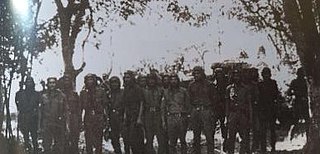
The Battle of Garibpur was fought between the Indian forces and Pakistani forces for the control of the village of Garibpur, now in Bangladesh. On 20 November 1971, Indian troops of the 14th Battalion of the Punjab Regiment with 14 supporting PT-76 tanks from the 45 Cavalry moved in to capture the areas around Garibpur in Pakistani territory. The battle started by Pakistani troops counterattacking the next day to recapture Garibpur.
The Battle of Boyra was a ground and aerial battle that was fought on 22 November 1971 between the India and Pakistan.
The Bangladesh Liberation War started on 26 March 1971 and ended on 16 December 1971. Some of the major events of the war are listed in the timeline below.
Operation Cactus Lilly, better known as The Meghna Heli Bridge or the Crossing of the Meghna, was an air assault operation conducted between 9 and 12 December 1971 during the Indo-Pakistani War of 1971. It was conducted by the Indian Army and Indian Air Force to cross the Meghna River, bypass a Pakistani stronghold at Ashuganj/Bhairab Bazar and reach Dhaka. The operation is generally regarded as the brainchild of Maj. Gen. Sagat Singh. Without it, Indian forces would not have been able to complete the encirclement of Dhaka and it would likely have led to a lengthening of the war.

Operation Jackpot was a codename for three operations undertaken by the Bengali Mukti Bahini in former East Pakistan against the Federation of Pakistan at the climax of the Bangladesh Liberation War.
Kader Bahini was an independent militia created during the Bangladesh Liberation War of 1971, the other being Mukti Bahini. It was named after its leader, Kader Siddique.
Task Force 74 was a naval task force that has existed twice. The first Task Force 74 was a mixed Allied force of Royal Navy, Royal Australian Navy, and United States Navy ships which operated against Japanese forces from 1943 to 1945 during the Pacific campaign. The second Task Force 74 was assembled from the U.S. Navy's Seventh Fleet that was deployed to the Bay of Bengal by the Nixon administration in December 1971 during the Indo-Pakistani War. The fleet was sent to intimidate Indian forces at the height of the conflict. The Soviet Union, which was actively backing Indian actions both politically and militarily during the war responded by deploying two groups of cruisers and destroyers as well as a submarine armed with nuclear warheads in response to the American military presence in the area. From 18 December 1971 to 7 January 1972, the Soviet Navy trailed the American fleet throughout the Indian Ocean. The task force number is now used by the U.S. Seventh Fleet's submarine force.
The Indian Army had no standby force ready in 1971 with the specific task of attacking East Pakistan, one of the many reasons why India did not immediately intervene after Pakistan launched Operation Searchlight in March 1971. Indian Army's Eastern Command was tasked with defending the northern and eastern borders and fighting the insurgencies in Nagaland, Mizoram and Naxalites in West Bengal at that time.
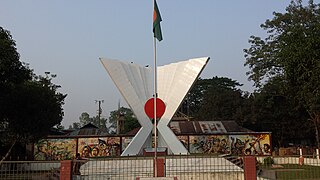
The Battle of Kamalpur, launched against the Pakistan Army, is one of the most significant military engagements fought by the Guerrilla armed resistance group, The Mukti Bahini in 1971 during it's war of independence from Pakistan. The Pakistani Army set up a military camp at Kamalpur which was attacked by 1st East Bengal Regiment of Z Force several times. The first attack was made on June 12, and a second attack was made on July 31, 1971, also another attack at 22 October 1971, in total there were 18 battles in Kamalpur, Syed Sadruzzaman Helal led 14 battles against the Pakistani Army which heavily weakened the Pakistani forces present in Kamalpur. India joined the war at Late November, they sent their military formations to take Kamalpur, but it was harder for the Indian Army than expected, they made more than 3 unsuccessful attempts to take Kamalpur, the Indian Army's moral was deteriorating, and Casualties were heavily increasing but they knew the Pakistani forces had no artillery, only 2 mortars left, finally, on December 4, the Pakistani Army was overrun and withdrawn and fell back to their headquarters at Jamalpur after an attack by the Bangladeshi Forces and the Indian Army. The Battle of Kamalpur was the deadliest major military engagement in the Bangladeshi War of Liberation, The Mukti Bahini lost 194 soldiers in the battle The Indian Army lost more than 46 soldiers in the battle and a 113 wounded Meanwhile, The Pakistani Army had the most casualties, The Pakistani Army lost 497 soldiers in the battle and around 162 and 220 soldiers captured In the aftermath of the battle, Pakistani troops were defeated and Jamalpur became liberated from Pakistani occupation.
The Eastern Command of the Pakistan Army was a corps-sized military formation headed by a lieutenant-general, who was designated the Commander Eastern Command. After the partition of India by United Kingdom, the Islamic Republic of Pakistan was divided into two territories separated by 1,000 miles (1,600 km). Most of the assets of the Pakistan armed forces were stationed in West Pakistan; the role of the Pakistan armed forces in East Pakistan was to hold that part of the country until the Pakistani forces defeated India in the west. The Pakistan Army created the Eastern Command, with one commander in the rank of Lieutenant General responsible for the command. The armed forces, had drawn up a plan to defend Dhaka by concentrating all their forces along the Dhaka Bowl.

Prior to Bangladesh Liberation War in 1971, India had no plans for large scale military action in East Pakistan. Since the Sino-Indian War of 1962, the primary objective of the Indian Army Eastern Command was the defence of the Indian northern and eastern borders, defending the "Shiliguri Corridor", and on combating insurgencies raging in Mizoram, Nagaland, Manipur and the Naxalites in West Bengal.
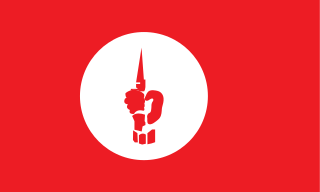
The Mukti Bahini, also known as the Bangladesh Forces, was the guerrilla resistance movement consisting of the Bangladeshi military, paramilitary and civilians during the Bangladesh Liberation War that transformed East Pakistan into Bangladesh in 1971. They were initially called the Mukti Fauj.
Z Force, also known as Tura Brigade, was the first military brigade of Bangladesh Forces formed during the Liberation War of Bangladesh in 1971 under Major Ziaur Rahman along with the consent of the revolutionary government of Bangladesh in exile. The brigade was formed with the 1st, 3rd and 8th Battalion of East Bengal Regiment on 7 July 1971. It is the first ever complete brigade formed during the Liberation War of Bangladesh in 1971.
The Bangladesh Freedom Honour is the highest state award given by the government of Bangladesh for foreigners or non-nationals. The award was posthumously conferred on former Indian prime minister Indira Gandhi on 25 July 2011. The award recognises her role as an ally during the Bangladesh War of Liberation and her capacity to manage such a complex regional war. A Bangladeshi national committee had nominated her for the special honour for her "unique" role in "offering training to freedom fighters and refuge to millions of people who fled the country and building world opinion for Bangladesh's independence". Indian National Congress Party president Sonia Gandhi, the daughter -in-law of Indira Gandhi, received the award from Bangladeshi President Zillur Rahman at a grand ceremony in Dhaka attended by Prime Minister Sheikh Hasina and nearly 1,000 top dignitaries.

Lieutenant Colonel (Retd.) Quazi Sazzad Ali Zahir is a veteran of the Bangladesh Liberation War. The Bangladesh government awarded him the Bir Protik gallantary award for his bravery in the war. He was conferred with the Independence Award, Bangladesh's highest civilian in 2013 and India's fourth highest civilian award the Padma Shri on November 9, 2021.
Mohammad Ziauddin, BU is a retired Bangladeshi military officer, who was the Commanding Officer of the 1st East Bengal Regiment during the Bangladesh Liberation War. He was awarded the Bir Uttom, the country's second highest gallantry award for his outstanding bravery in the Liberation War. His certificate number was 22.







